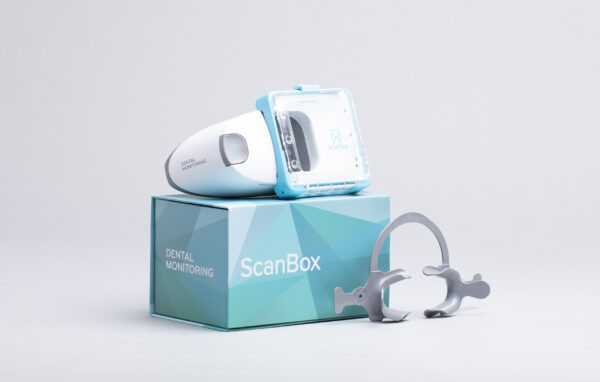The device looks like a virtual-reality headset. But instead of covering people’s eyes, it peers into their mouths.
A teledentistry startup — Candid — hopes the device can give it an edge in the crowded field of straightening people’s teeth.
The company is one of several offering clear teeth aligners and treatment plans to match. This year the company has been field-testing a technology called Dental Monitoring that involves handing patients a connected device, called a ScanBox. The device connects to a patient’s smartphone, captures images and sends them to a remote orthodontist. The uploaded images also are scanned using an AI algorithm that can track a patient’s progress, assess their oral hygiene and detect any potential health issues, such as visible cavities or gingival recession.
Patients are asked to send images every seven to 10 days, more often than they would go for checkups at a traditional orthodontist, said Dr. Lynn Hurst, chief dental officer for Candid, in a phone interview.
Hurst, who is based in Austin, Texas, had been using an earlier version of the technology in his own practice since 2016. The introduction of the ScanBox has made it easier to use, he said.
“It’s extremely robust,” Hurst said.
Based in New York City, Candid was founded in 2017 and features a network of several dozen orthodontists. Some patients may be assessed in one of Candid’s retail studios in major cities like Atlanta, Chicago, San Diego and Seattle. Others come through online channels.
An orthodontist reviews each patient’s case, determines whether they are eligible for treatment and, if so, comes up with a treatment plan. The aligners are then mailed to patients, who generally must be at least 16 years old and have mild to moderate alignment issues. Orthodontists monitor their treatment.
Altogether, the program costs about one-third as much as traditional teeth straightening, said Nick Greenfield, Candid’s president and CEO.
Dental Monitoring will add a couple hundred dollars to the price. But patients using the ScanBox have been more likely to stick to their treatment plans and complete their plans more quickly, Greenfield said in a phone interview. Compliance typically is around 80% range. Patients on Dental Monitoring were 95% compliant, he said. And their treatment time was 27% shorter on average.
The company evaluated other devices but its orthodontists liked the Dental Monitoring program best. The ScanBox and the program are the products of a company itself called Dental Monitoring.
“For us it was a really exciting opportunity,” Greenfield said, adding that Candid’s goal is to make care safe, accessible and affordable.
The global market for clear aligners is valued at roughly $2.2 billion but is expected to reach $8.2 billion by 2026, according to a report by Fortune Business Insights. Candid has plenty of company in the market. There are Invisalign clear aligners made by Align Technology Inc. and mail-order provider SmileDirectClub Inc. SmileDirectClub went public this year but has faced criticism, as has remote orthodontics in general. The American Association of Orthodontists has issued a consumer alert on direct-to-consumer orthodontic companies.
However, Candid executives defended their approach saying that it exceeds the standard of care offered in bricks-and-mortar offices.
“Not only am I doing what they’re doing in their practices, I’m actually going beyond that,” said Hurst, a co-founder of Candid. He sees patients through the Candid platform and noted that it is designed and implemented by orthodontists themselves.
“I think that’s extremely critical,” Hurst said. “We’re the experts in that space.”
Hurst was one of five orthodontists in the Candid network who field-tested the Dental Monitoring program. It was offered first to patients who came in through Candid’s studios, where aides could train patients in using the ScanBox. In early 2020 it will be available to patients online.
The program also could allow Candid to expand into moderate and moderate-to-severe cases of misaligned teeth, a condition known as malocclusion, Hurst said.
For now, he said, “We’re just choosing to stay in the shallow end of the pool.”
Hurst said his practice also has been testing remote services for patients under 16, though it means ensuring parents are on board as well.
So far Hurst has tested starting treatment of children with in-person consults at a Candid studio and with remote consults via audio-video conference. Those have gone well, he said. The next step is to start treatment entirely online, where a patient uploads information and waits for the orthodontist’s response and treatment plan.
“Ultimately our patients will tell us, and our parents will tell us, does that make them comfortable,” Hurst said.
Photo: Candid
CORRECTION: An earlier version of the story wrongly identified the chief dental officer of Candid. His name is Lynn Hurst and not Nick Hurst. The company is based in New York, not Austin.
















